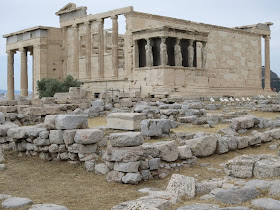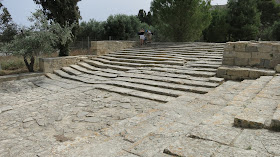 |
| A transept of St. Lazare, Autun, built around 1120 has tall arches and a blind arcade like many late Roman buildings. The rib vaults vault are an innovation of Romanesque |
Romanesque is the name given today to that style of art, reflecting its common traits with Roman architecture: arches, barrel vaults and groin vaults. Although the library at the monastery of Cluny, in Burgundy, had a copy of the Roman architect Vitruvius' treatise on architecture which described how to make concrete, the medieval builders did not use concrete. They looked at the stones around them, used their compasses and measures, and created a marvelous revival of monumental building. It was a time of pilgrimages and Crusades, and stone masons moved from place to place, spreading architectural ideas.
 |
| Porte d'Arroux is the best preserved of four gates erected in Autun during Roman times. |
In the first centuries of Christianity, builders reused Roman columns, which were plentiful in the forums surrounding civic buildings of the ancient cities. Romanesque sculptors invented their own style of column capitals and used them to tell stories in sculpture. Even in monastery churches, Romanesque builders needed to allow for pilgrims coming to see relics and they built big. For the proportion of nave arcades to the upper levels of churches, the gallery and clerestory, they took some cues from Roman buildings, aqueducts and gates and made the upper levels smaller. At times, late Roman architecture of the 3rd and 4th centuries, which tended to be more organic and experimental than buildings from the Augustan age, probably served as models.
 |
| Porte St-Andre is one of the two Roman gates standing in Autun, Burgundy, although much of it was restored in the 19th century. |
Outside of Autun, the remains of a temple to Mars or Janus, of Gallic fanum design, has magnificent high arches that reminded me of Arches National Park in Utah. Two Roman gates and the remnants of a Roman theater are in Autun, also. It's surprising so much remains, because the city was sacked by both Saracens in the 8th century and Vikings in the 9th century. Because of the richness of the ruins, it's not surprising that some of the greatest cathedrals from Romanesque times were built in the Burgundian region of east-central France: St. Lazare in Autun, Ste. Madeleine in Vézelay, St. Philibert at Tournus, and, above all, St. Pierre at Cluny. The church at Cluny remained the largest Christian church until St. Peter's, Rome, was completed in the 17th century. Most of it was damaged during the French Revolution.
 |
| The Baths of Constantine, Arles dated to the 4th century |
 |
| The curved Roman exedra form of this bath building was imitated in the curved east end of Romanesque churches |
Most art historians talk of the relationship between the design of triumphal arches and the facades of churches in Provence. Certainly the abundant decorative details of churches in Provence, including Saint Trophime in Arles, is in imitation of classical decorative motifs. This church and others in Provence had continuous bands for narrative sculpture, called friezes, as on classical buildings.
 |
| In Nîmes, the remains on the inside of a 3rd century Temple to Diana, may have inspired the design of the tympanum and barrel vault, standards for Romanesque church design |
However, I note the similarity between St.-Gilles-du-Gard, in the Rhone delta, and the building traditionally considered a Temple of Diana in Nîmes, probably from the 3rd or 4th century. It provides a model for the shape of a tympanum, an important field for sculpture over the doorway of Romanesque churches. Only portions of the interior remain, with the beginning of a reinforced barrel vault, pediments and pilasters. It is easy to see how the shapes of Roman buildings determined some shapes in the churches and cathedrals. Certainly the doorways at St.-Gilles resemble three-part triumphal arches, like the Arch of Constantine or triumphal arch in Orange (see photo on bottom).
When Romanesque builders took inspiration from ancient art and architecture, they added much of their own creativity and ingenuity. They began to make the arches taller, the vaults more elaborate and pointed, reflecting their borrowings from Islamic architecture during and after the Crusades. (One such Romanesque Church, which took in so many diverse influences, including sculpture in the style of Provence, is Monreale Cathedral, discussed previously on another page in this blog.)
 |
| The Triumphal Arch in Orange, France was a richly ornamented, a trait carried over in the Romanesque churches of Provence |
When it came to sculpture, they were very imaginative, whimsical and emotionally expressive of the religious zeal of a bygone age. At times, they re-used classicism in ways that would not have been acceptable at all, as in Sainte-Marie de Nazareth in Vaison-la Romaine.
Romanesque architecture developed very quickly and led to the Gothic style, which began in Paris around 1150 and spread almost everywhere within a century.
The Via Lucis website has the best and most comprehensive photographs and explanations of Romanesque art and architecture.










































.jpg)
